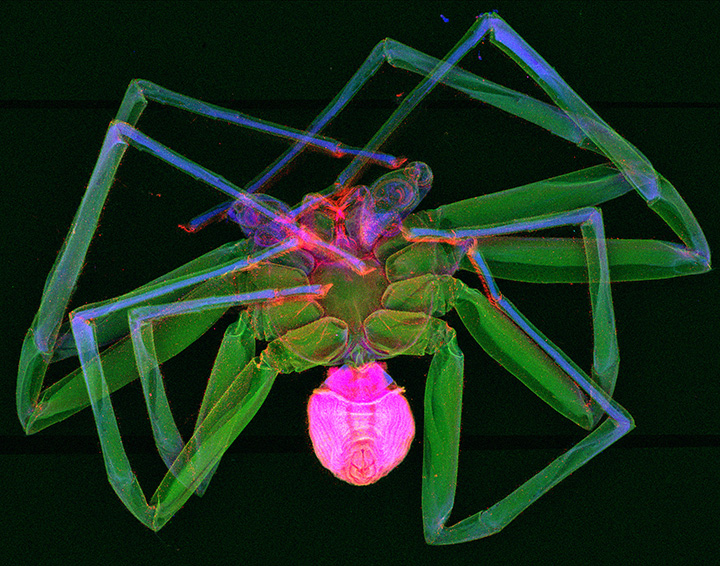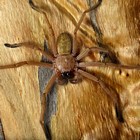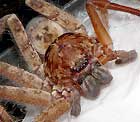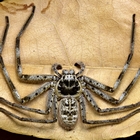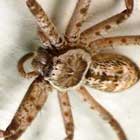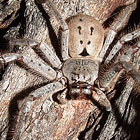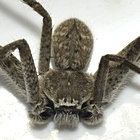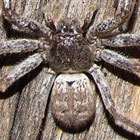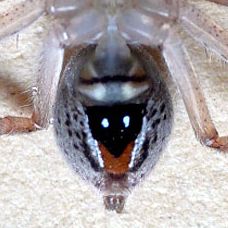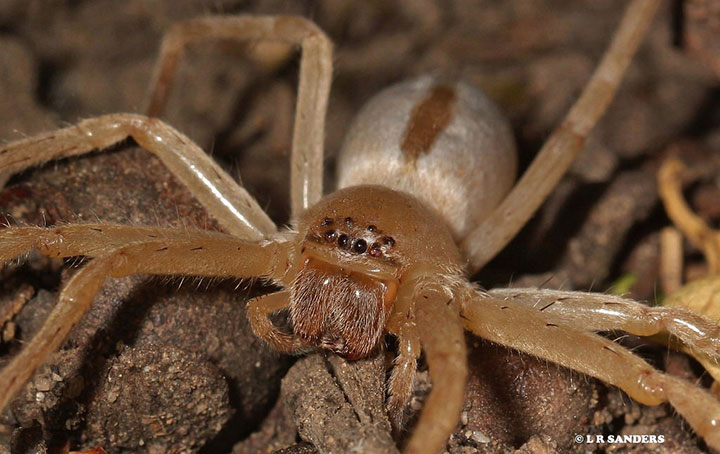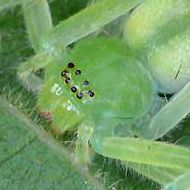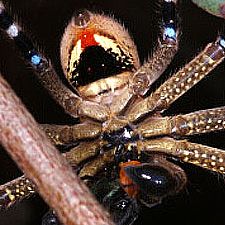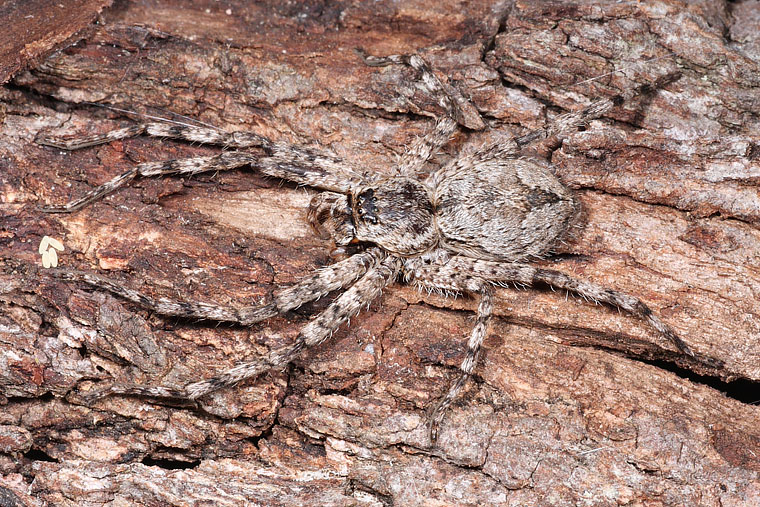Have you ever wondered what elements make up a spider's body? Scroll down or use these links to see.
- Manganese red, Potassium green, Copper blue
- Iron yellow, Zink pink, Copper blue
- Zinc pink, Potassium green, Copper blue
Huntsman Spiders have probably been responsible for more shrieks of terror than any other spider in Australia. They are big, fast and when disturbed will run up your arm, over your neck, down your shirt or over your face. It can be an unsettling experience. Even the most experienced arachnologists have been known to yelp when it happens.
Huntsman Spiders in Laos can have a leg span of up to 300 mm. The first two pairs of legs are usually the longest. The legs tend to go sideways from the body and because of this crab-like arrangement the direction they run in can be unpredictable.
Because Huntsman Spiders are big, they are capable of inflicting bites if trapped or provoked, but they would usually rather run away. The medical effects of bites are minor. The greatest danger is when people panic, especially when driving. If you can possibly manage it, try to remain calm, find somewhere safe to stop and take a break. The spider will soon go away. It doesn't like being out in the open during the day. Sparassids have eight eyes in two more or less straight rows, the largest usually the outermost on the front row. The carapace is oval and flattened, squared off at the front in the eye region.
They have long legs ending with two claws and dense tufts of hairs. In nature they are mostly found under bark, sometimes dozens or more under bark on dead trees. Some live in rock crevices.
In houses they find places to breed under or behind objects or surfaces protecting them from light. Females make a roughly circular egg sac.
They can be small but most are large, the largest over 40 mm in body length. Huntsman Spiders are found mostly in warmer places and are very common in northern Australia. They are easy to find at night by eye shine. Courtship may involve drumming, with rhythmic vibrations attracting females.
Beregama is a large Huntsman Spider genus found in wetter forests in northern Australia. Even though timid, Beregama spp. are capable of inflicting a bite but there are no known serious medical consequences. Beregama spp. are similar to Neosparassus spp. but larger and without a black badge on the underside of the abdomen
Delena cancerides spread from Australia to New Zealand and is now known there as the Avondale spider, being common in the suburb of Avondale, Auckland. This was the species used in the beginning of the movie Spider-Man and in Arachnophobia. It is not dangerous. It is also called the Social Huntsman Spider, often found under loose bark in colonies of up to 300 individuals. The Latin cancerides means crab-like, referring to the spider's capacity for sideways movement.
Neosparassus spp. are medium to large Huntsman Spiders, not as flattened as many others. They have vivid badges on the underneath of the abdomen, hence the common name Badge Huntsman Spiders. Many are green when juvenile, some retaining green colouration when adult. These were previously known as Olios. Heteropoda is currently the most diverse sparassid genus with over 40 species, mostly in tropical to subtropical areas.
Delena cancerides Walckenaer, 1837 Social Huntsman
One of Australia's largest Sparassids (leg spans exceeding 140mm), the Social Huntsman is found in the south-west and east of mainland Australia,... 
Heteropoda jugulans (Brisbane Huntsman)
The Brisbane Huntsman is a large, mottled-brown, common, fast-running ground dwelling spider often found in leaf litter. They shelter under bark... 
Holconia flindersi Hirst, 1991 Flinders Banded Huntsman
A black and grey banded, large huntsman found from the Flinders Ranges in South Australia, east to Broken Hill in New South Wales and Meringur in the... 
Holconia immanis - Grey Huntsman
A black and grey banded, large huntsman found from the Flinders Ranges in South Australia, east to Broken Hill in New South Wales and Meringur in the 
Holconia insignis (Thorell, 1870) Branded Huntsman
This sparrassid is not as common as H. immanis, recorded only for Queensland and New South Wales. First described as Voconia insignis... 
Isopeda montana Hogg, 1902 Mountain Huntsman
The Mountain Huntsman has been found in most habitats in southern Victoria, sharing them with the Victorian Huntsman Isopedella victorialis. 
Isopedella cerussata (Simon, 1908) Southern Grey Huntsman
A grey, medium-sized huntsman found in semi-arid areas of south-central Western Australia, South Australia, north-west corner of Victoria, NSW and... 
Isopedella victorialis Hirst, 1993 Victorian Huntsman
A grey, medium-sized to large huntsman in Victoria, often seen around houses and gardens. Despite its name this spider has also been recorded from... 
Neosparassus diana (L. Koch, 1875) Badge Huntsman
The Badge Huntsman widespread across all of Australia in woodland and dry to moist eucalypt forest, less common in the tropical north and the arid areas. It is a large spider, active at night, hunting for prey on treetrunks or on foliage. It has a daytime retreat, sometimes made from leaves woven... 
Neosparassus sp Green Huntsman
David Hirst (SA Museum) writes: "At a guess this one should be another undescribed species that is green in life even as an adult ... found from... 
Neosparrasus calligaster (Thorell, 1870) Beautiful Badge Huntsman
A large spider whose range is concentrated in inland NSW and Victoria but has been recorded also from coastal parts of eastern Australia north to... 
Pediana regina (L. Koch, 1875) Queen of the Huntsmans
The mature female of this sparassid is about body length 25 mm, the male around 19 mm. It is found on tree trunks or under loose bark in eucalypt forests. Being large, it is potentially hazardous to humans so handle with caution. The legs do not curve forward to the same extent as for most other... 
Manganese red, Potassium green, Copper blue
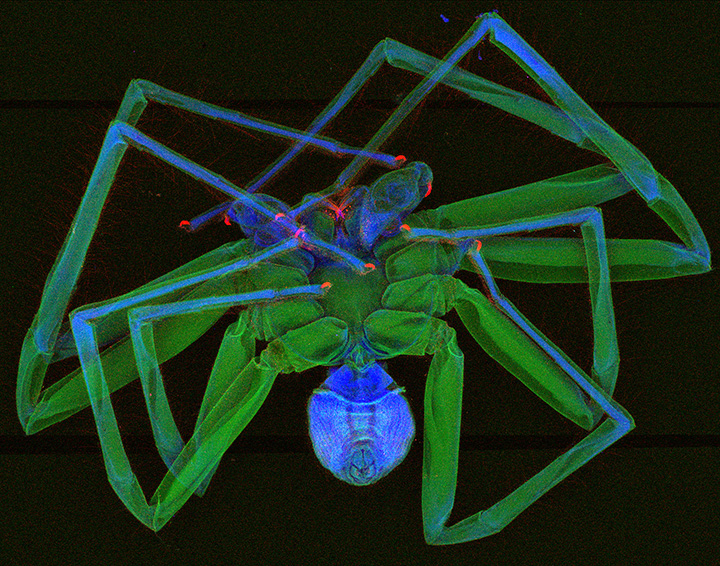
Iron yellow, Zink pink, Copper blue
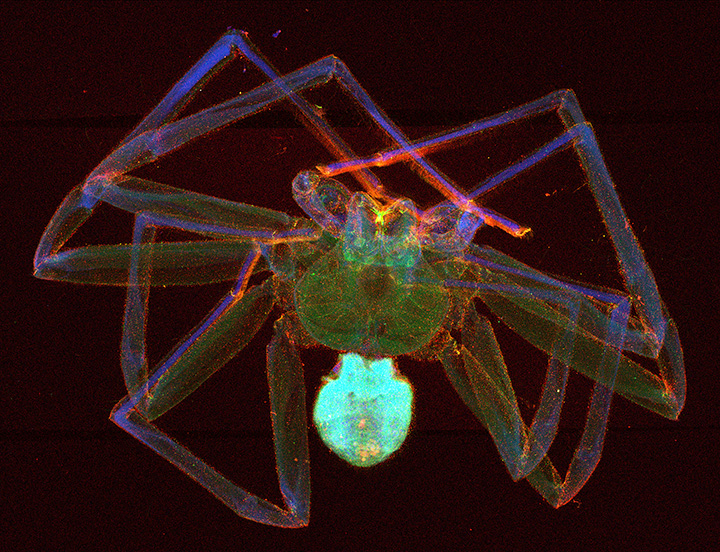
Zinc pink, Potassium green, Copper blue
